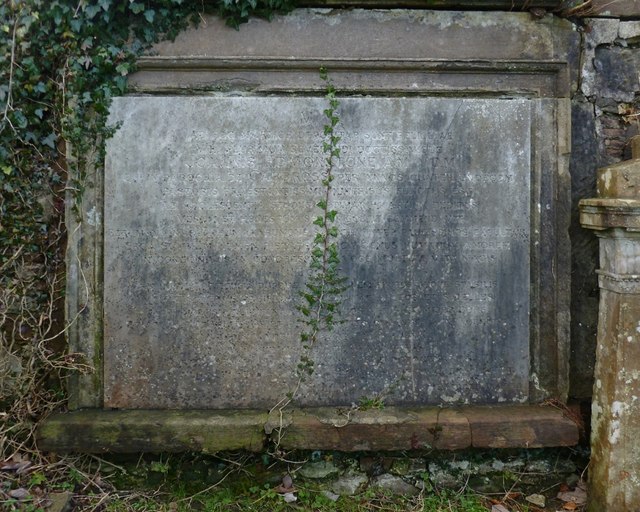Memorial to John Edmonstone
Introduction
The photograph on this page of Memorial to John Edmonstone by Lairich Rig as part of the Geograph project.
The Geograph project started in 2005 with the aim of publishing, organising and preserving representative images for every square kilometre of Great Britain, Ireland and the Isle of Man.
There are currently over 7.5m images from over 14,400 individuals and you can help contribute to the project by visiting https://www.geograph.org.uk

Image: © Lairich Rig Taken: 18 Jan 2013
This white marble tablet (or rather its predecessor — see the end of this description) was erected in June 1772; it is set in the south-west wall (the side nearest the main road) of the churchyard of Image - - • - - M.S. ad hoc marmor depositae sunt reliquiae viri plurimum reverendi doctissimique JOANNIS EDMONSTONE A.M. V.D.M. qui in parochia de Cardross per annos quater undecim pastoris praestantissimi muneribus functus est. ab adolescentia studiis optimarum artium deditus verum et honestum sensit, coluit, commendavit. rerum divinarum humanarumque scientia, inter paucissimos, excultus. erga summum numen pietatem, erga genus humanum amorem, in concionibus, in congressibus, voce multum, vita magis, docuit. ab initiis officiis adusque vitae finem firmus atque stabilis virtutis verae pacifique Christianae custos et satelles. in rudiores hallucinantes devios mitis et misericors: etiam in turbulentos et pervicaciter rixantes vix acerbus. mensis Martii XXI anno MDCCLXXI, annis gravis, pietate gravissimus, mortem sensibus placidissimus obiit octogenarius. Andreas filius natu maximus parenti optimo moerens posuit. V.S.L.M. Restored in 1938. - - • - - The Latin text of this inscription can be found in several old books, cited at the end of this item. They all differ to some extent from the actual inscription. I've attempted to reproduce exactly what is on the stone. (1) A.M.: "artium magister" (the academic qualification M.A.). (2) V.D.M.: "verbi dei minister", "minister of the word of God"; broadly equivalent to "the Reverend". (3) V.S.L.M. ("votum solvit libens merito"): a votive formula that appeared on the base of some Roman altars, etc. It is not worth giving the full translation of the inscription here, since it provides very little in the way of biographical details, other than that John Edmonstone performed the duties of a pastor in this parish for 44 ("quater undecim", 4 × 11) years; that he died on the 21st of March 1771, in his 80th year; and that the stone was erected by his eldest son Andrew (on whom, see Image). The second volume of Joseph Irving's "Book of Dumbartonshire" (1879), on pages 360-65, gives the succession of ministers in Cardross Parish from 1480 to 1838: Archibald Wallace was admitted in 1695, and died in 1725. The Crown presented John Smith, who was rejected by the parishioners; they gave the call to John Edmonstone, who was ordained in 1726. As noted above, Edmonstone died in 1771. John Davidson, minister of Old Kilpatrick, declined the charge, and the Harris-born John McAulay was inducted minister of Cardross parish in 1774. A much more detailed discussion of these matters can be found in Eunice G Murray's "The Church of Cardross and its Ministers" (1935). - - • - - Citations for some transcriptions of the Latin inscription (lines numbered from 1 at "ad hoc ..."): (1) Second volume of Joseph Irving's "Book of Dumbartonshire" (1879), footnote on page 363. Variant readings: "deditius" (line 6); "vitae finem stamins, firmus" (line 12); "pacisque" (line 13); "in rudiores et labascentes mitis" (line 14); "Etiam in turbulentos, vix acerbus" (line 15); line 17 ("annis gravis, pietate gravissimus") is omitted altogether. (2) Donald MacLeod, "Historic Families ... of the Lennox" (1891), page 51. The Latin text is exactly as in Irving, with the same variant readings, and was presumably taken from there, rather than from an inspection of the stone itself (note that Irving was a friend of MacLeod, and would have allowed him to draw upon his work in this way). MacLeod also supplies his own English translation, which is useful. (3) "The Scots Magazine", Vol 34 (1772), page 621, gives the Latin text with little further comment, although it does give the date, June 1772, when the stone was erected. Note that the inscription was, when this transcription was published, freshly-cut. It is therefore not surprising that this version is, by far, the closest to what is on the stone. The sole variant readings are: "EDMONDSTONE" (line 3), and "pacisque" (line 13). These transcriptions all say "pacisque", whereas the stone currently reads "pacifique". The 1935 book "The Church of Cardross and its Ministers", cited above, describes John Edmonstone's memorial as being on the south wall of the churchyard, and, as having, in addition to the lengthy Latin inscription, a skull, cross bones, and an hour glass. The latter features are no longer present. While it is possible that the inscription somehow became detached from the rest of that structure, it seems more probable that the 1938 restoration involved the creation of an altogether new inscription tablet. The stone does indeed seem recent: its surface seems fresh, its edges are sharp, and the lettering is clear and cleanly incised. Its being a re-creation would also account for the minor discrepancies in its text, as compared with older transcriptions; in particular, it would explain the untranslatable "pacifique" of the current inscription, which is, I am guessing, the result of a misreading of an original "paciſque".

